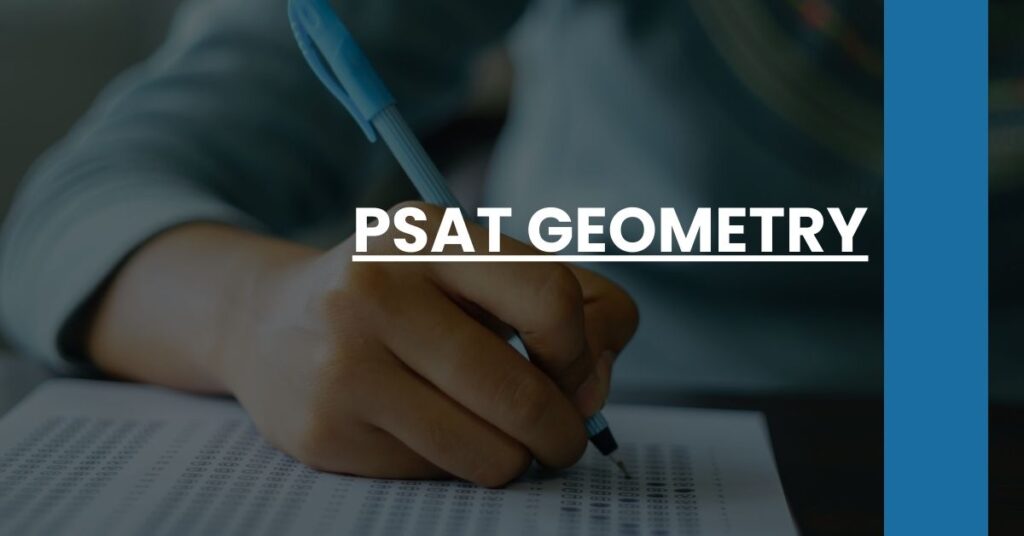PSAT geometry questions driving your test prep? We’re here to help you navigate through those tricky areas.
- Key Concepts in PSAT Geometry: Get to grips with angles, shapes, and formulas essential for the test.
- Effective Preparation Strategies: Tailor your study plan with proven techniques that boost your PSAT geometry skills.
- Time Management Tips: Learn to allocate your test time wisely to tackle geometry efficiently.
Ace your PSAT geometry section with strategic focus and practice.
- Understanding the PSAT Math Section
- Key Geometry Concepts on the PSAT
- Problem-Solving Strategies for Geometry Questions
- Common Geometry Problem Types and How to Solve Them
- Practice Problems and Solutions
- Geometry Formulas to Memorize
- Tips for Effective PSAT Geometry Preparation
- Managing Time During the Geometry Section
- Importance of Practice Tests in Geometry Preparation
- Conclusion: Preparing for Success on PSAT Geometry
Understanding the PSAT Math Section
When diving into the world of PSAT geometry, it’s paramount to grasp the architecture of the Math section. You will encounter a blend of multiple-choice and grid-in questions, with geometry playing a crucial role within this tapestry of numbers and figures.
The Layout of the Test
Geometry weaves its way through 44 questions split between two subsections. The first allows you a luxurious 45 minutes with a calculator at your side. The second, a more concise 25 minutes, invites you to rely solely on your mathematical prowess. This structure is designed to evaluate your fluency in math and, more importantly, your ability to apply the principles of geometry to solve real-world problems.
The Cornerstones of PSAT Geometry
In your journey through PSAT geometry, you’ll meander through questions revolving around area, volume, and the stoic angles of various shapes. Why does this matter? These concepts form the bedrock of the Math section, and your familiarity with them dictates your readiness for future academic endeavors.
The Weight of Geometry Questions
Expect geometry to command a significant position in your PSAT Math performance. It’s not just about calculating measurements; it’s about interpreting figures spatially and understanding how geometric formulas apply to different shapes and configurations.
Key Geometry Concepts on the PSAT
The PSAT is not merely a test of your memory but a quest to see how well you understand and can utilize fundamental geometry concepts. Here are the geometry champions to watch out for:
- Lines and Angles:
Delve into the world of parallel and perpendicular lines, explore the properties of different angle types, and dissect the nuances of angle relationships. - Triangles and Polygons:
Revel in the realm of isosceles and equilateral triangles, grasp the intricacies of polygons, and get acquainted with the triangle inequality theorem. - Circles:
Circumference and area calculations of circles become second nature, and you’ll converse with the elegance of pi as if an old friend.
Digesting Geometry on the PSAT: Step-by-Step
- First key idea: Visualize the problem. Don’t just see the numbers; paint a picture in your mind to understand the spatial relationships at work.
- Second key idea: Diagrams aren’t just for architects. Sketching a rough visual can simplify perplexing problems, untangling the tangles of lines and angles before you.
Problem-Solving Strategies for Geometry Questions
Facing Geometry Problems Head-On
Approach each geometry problem with a cool, collected intellect—your clarity of mind can often be the chisel that sculpts the solution out of the marble block of confusion. You’ll want to:
- Dissect the question: Break it down into manageable bits.
- Apply the concepts: Use just the right formulas and theorems.
- Employ reasoning: Sometimes intuition leads you to the solution faster than computation.
The Method of Elimination
It may sound dramatic, but eliminating answers one by one can be a rigorous path to the truth. Strike off the obviously incorrect choices and weigh what remains. Often, the answer will emerge through sheer deductive reasoning.
Understanding Geometric Principles
Solidify your grasp on the psat geometry principles and you’ll find that even the most complex-looking problem is but a house of cards waiting to collapse under your focused gaze.
Common Geometry Problem Types and How to Solve Them
When you encounter geometry on the PSAT, keep a lookout for these common culprits:
- Area and Perimeter Problems: A staple of geometry questions, where you must remember key formulas and apply them correctly.
- The Grace of the Pythagorean Theorem: Triangular troubles often call for this theorem by name; knowing it intimately can resolve many a geometric dispute.
- Properties of Lines and Angles: Tackling these questions is a matter of recognizing the relationships and applying clear, logical steps to find the answers.
Attending to these problem types with methodical precision will elevate your chances of scoring impressively in the Math section.
Practice Problems and Solutions
To fortify your psat geometry skills, here are several representative problems followed by solutions to help solidify your understanding of the material:
- A Triangle Within a Triangle:
Problem: A right triangle with legs of 6 and 8 contains a smaller, similar triangle with a hypotenuse of 5. Determine the area of the smaller triangle.
Solution: Recognize the similar triangle properties and apply area ratios to find that the smaller triangle’s area is 6. - Rectangles and Algebra:
Problem: A rectangle has a perimeter of 50, and its length is twice its width. Find the area of the rectangle.
Solution: Set up an equation with ( L = 2W ) and ( P = 2L + 2W ), solve to find the dimensions, and then calculate area using ( A = L \times W ). - The Circle’s Secrets:
Problem: Find the area of a circle with a radius that is one-third the diameter of a second circle with an area of 36π.
Solution: Use the area formula ( A = πr^2 ), deduce the radius of the second circle, then divide by three for the first circle’s radius and find its area.
Immersing yourself in practice problems like these enhances not just your familiarity with psat geometry questions but also your confidence—making you a force to be reckoned with come test day.
Geometry Formulas to Memorize
When it comes to PSAT geometry prep, possessing a mental toolbox of essential formulas is a game-changer. Having these formulas at the ready during the test can be the difference between a good score and a great one.
Critical Formulas for Your PSAT Success
- Area of a Triangle:
Formula: ( A = \frac{1}{2} \times base \times height )
Understanding this relationship is crucial for questions about two-dimensional figures. - Pythagorean Theorem:
Formula: ( a^2 + b^2 = c^2 )
Handy for right triangles, this theorem is a faithful ally in many PSAT geometry questions. - Circumference and Area of a Circle:
- Volume Formulas:
- Special Right Triangles:
By committing these formulas to memory, you pave a smoother path for solving psat geometry problems with speed and precision. Establishing links between formulas and their real-world applications not only aids in memorization but also deepens your understanding.
Tips for Effective PSAT Geometry Preparation
Preparation is the cornerstone of psat geometry mastery. Adequate prep can demystify the test’s complexity and hone your proficiency.
Customizing Your PSAT Study Plan
- Identify Weak Points:
Diagnose your geometry challenges and focus on turning them into strengths. - Quality Over Quantity:
Consistent, focused study sessions hold more value than sporadic cramming. - Resource Utilization:
Leverage available tools such as online tutorials and PSAT practice tests to get a real feel for the test’s format.
A fine-tuned study schedule tailored to fit your needs and learning style can significantly enhance your geometry skills. Remember, active learning is more impactful than passively reading through formulas.
Leveraging Technology in PSAT Geometry Prep
Do not underestimate the power of digital platforms in your PSAT preparation works. Apps and online platforms offer interactive experiences that can cement your conceptual understanding.
Managing Time During the Geometry Section
Time can be your ally or adversary during the PSAT geometry section. Thus, mastering the clock is part of the equation for success.
Efficient Approaches to Geometry Questions
- Prioritize the Familiar:
Tackling questions you’re comfortable with first can build confidence and secure quick wins. - Mark and Move On:
When stuck, make a quick note and proceed to the next question. Circling back later with fresh eyes could be key. - Rapid Review:
If time allows, revisit your answers. An extra glance may catch mistakes or glimpses of insight you previously missed.
Time management skills improve with practice. Simulate test conditions with PSAT practice exams to build this crucial competency.
Importance of Practice Tests in Geometry Preparation
Practice tests are not mere rehearsals—they’re vital for transforming knowledge into application under test conditions.
Benefits Beyond Familiarity
- Measuring Progress:
Gauge your growth and adjust your study plan accordingly. - Simulating Real Test Scenarios:
Accustom yourself to the pressures and pacing of the actual exam day. - Refining Strategies:
Identify which problem-solving tactics serve you best and which are in need of tweaking.
The Role of Reviewing Practice Tests
After completing each practice test, thoroughly review your responses. Doing so illuminates patterns in your problem-solving approach and pinpoints areas for improvement.
Conclusion: Preparing for Success on PSAT Geometry
Embarking on a PSAT geometry preparation journey can be daunting. Yet, it’s a path lined with opportunities for personal growth and academic achievement. Channel the stress into motivation. With each practice problem you surmount, with each formula you memorize, you’re not just preparing for a test—you’re building a foundation for future learning.
Your success on the PSAT geometry questions is a matter of strategy, practice, and confidence. Keep your study regular, your mind curious, and your goals clear. The PSAT is not just a stepping stone to college admission; it’s a platform for proving to yourself just what you’re capable of achieving. Dive into your prep with vigor, and let the principles of geometry guide you to a score that reflects your true potential.

